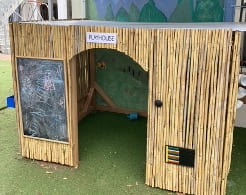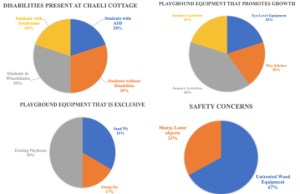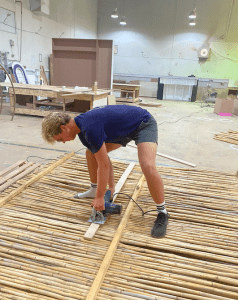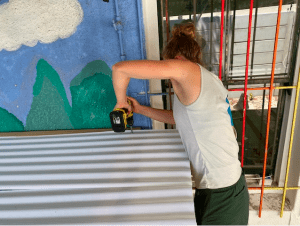Adapting an Inclusive and Accessible Playground at Chaeli Cottage Preschool
Sponsoring Organization: The Chaeli Campaign
Sponsor Liaison: Rosemary Lugar
Team Members: Nicholas Battaglino (Civil Engineering ’24), Amanda Borden (Mechanical Engineering & Environmental and Sustainability Studies ’24), Kayla Condon (Biomedical Engineering ’24), Henry Sniezek (Industrial Engineering ’24)
Advisors: Professor Gbetonmasse Somasse & Thidinalei Tshiguvho
Abstract
Children with disabilities in South Africa don’t have access to quality education, including inclusive playgrounds. This project adapted a playground at Chaeli Cottage preschool to be more inclusive and accessible for students of all abilities. To create a beneficial product, our team conducted interviews with professionals and observed early childhood development centers to understand the needs of the users. We designed and built an inclusive playhouse, created a communication poster, and contributed to fundraising strategies at The Chaeli Campaign.
Links:
Final Presentation- Adapting an Inclusive and Accessible Playground at Chaeli Cottage
Maintenance Guide for Playhouse
IQP Report, Adapting an Inclusive and Accessible Playground
Hand Drawing Design of Playhouse
Executive Summary
Children with disabilities don’t have adequate access to the quality education that their able-bodied peers receive, which makes it harder for them to follow the same path as their peers as they get older. In addition, children with disabilities are rarely given access to an inclusive and accessible playground. Playgrounds are important in the development of social, cognitive, and emotional growth and are therefore an essential part of a child’s education.
The goal of this project was to adapt and create an inclusive and accessible playground for Chaeli Cottage, an inclusive early childhood development (ECD) center in Cape Town, South Africa. This ECD is run by The Chaeli Campaign, a nonprofit social justice organization with a mission to fight for disabled people’s rights and provides resources to those in need.
To achieve the project goal, we:
- identified the needs of all users of the playground by conducting interviews with professional staff and observing students at ECD centers in Plumsted, Ocean View, and Masiphumelele.
- expanded The Chaeli Campaign’s fundraising opportunities by interviewing the Manager of Relations and Funds to understand current fundraising strategies and participated in various fundraising events.
- created and tested an inclusive and accessible playground design by conducting interviews with staff at The Chaeli Campaign to acquire available resources and created a rendering of our design through Computer-Aided Design software.
Key User Needs and Desired Elements of the Playground Design
As seen in Figure 1, the majority of students at Chaeli Cottage have disabilities including Autism Spectrum Disorder (ASD), various syndromes, and using wheelchairs. Additionally, 50% of students have difficulty communicating verbally. Based on our observations at Chaeli Cottage, wheelchair users and students with visual impairments were most often left out of play during free time. Professional staff explained that sensory items are most beneficial to the growth and development of children, while a play kitchen, inclusive elements, and equipment that allows for eye-level interactions among peers are also important. Most people interviewed said that the playhouse was the most exclusive element on the playground, followed by the sand pit and then the swing set. Finally, the professional staff explained that untreated wood equipment and sharp, loose objects were safety concerns that they had with playground equipment.
An Inclusive Playground Design
To address the needs, challenges, and requirements of an inclusive playground, we created two key deliverables: a communication poster and an inclusive playhouse.
Communication Poster
With this information, we suggested and created a poster to support students with difficulties communicating. This poster includes labeled pictures of the equipment on the Chaeli Cottage playground to allow students to point and use their eyes to communicate their wants (Figure 2).
Inclusive Playhouse
Our team designed and built an accessible and inclusive playhouse for students of all abilities (Figure 3). The key features of the playhouse were its size, sensory activities, and a sand table. The playhouse is large enough for wheelchair users to easily enter and move around inside. The sensory activities were chosen to be activities that all students could participate in, as well as allowing students to practice important skills like motor control and talking. A sand table was designed to sit inside and outside of the playhouse to allow as many children to play as possible. The height of the table was determined based on the average height of wheelchairs and standing frames as well as the heights of the children at Chaeli Cottage.
The materials chosen for the playhouse were based on natural elements and meant to mimic infrastructure in Cape Town (Figure 4). This includes a flat roof made from white DUROplastic to allow sunlight through. The walls of the playhouse were made from bamboo for two main reasons: the natural elements have been proven to have calming effects on children, and the natural gaps allow sunlight and visibility throughout the walls.
A maintenance guide was created in addition to the playhouse to provide The Chaeli Campaign with the necessary information (Appendix F). This included a CAD rendering of the playhouse to show accurate dimensions, a hand drawing of all walls of the playhouse to show inclusive elements and a list of materials used in the building process.
A Registry for Consumable Products to Alleviate Financial Pressure
To expand The Chaeli Campaign’s fundraising opportunities, our group first learned the current strategies that are being used. The Chaeli Campaign receives most of its funding from grants, including CSI funding and marketing budgets from large companies. To raise money for a specific need, such as a wheelchair for a child, fundraising events are utilized. To acquire funds for day-to-day operations, The Chaeli Campaign uses a donor subscription strategy.
To help alleviate financial pressure, our group created a registry using GoFundMe to collect money for the consumable products at both The Chaeli Campaign and Chaeli Cottage. Our goal was to raise enough money for two months’ worth of supplies. As of December 16, 2022, we collected $527 (R9,199.68). To help The Chaeli Campaign find grants, our team found two free grant databases to eliminate the need to pay for a database subscription. These websites are Grantmakers.io and fundsforNGOs, which provide information to find grants that The Chaeli Campaign can apply as well as a newsletter that emails the information to organizations directly.
The limitations of our project are as follows:
- This project was focused only on Chaeli Cottage and the disabilities of current students. Therefore, this sample of students is not representative of the whole disabled population and the final designs may not be inclusive of all disabilities.
- The final playhouse required a budget that was more expensive than anticipated.
Recommendations
Based on our findings, we recommend that Chaeli Cottage include the following in future additions to the playhouse:
- Multiple heights to the sand table: Therapists requested that there be multiple heights of the sand table to allow play for all students.
- Additional sensory activities: As the sample of students at Chaeli Cottage changes, it will be beneficial to the students to change the sensory activities to those that are tailored towards their wants and needs.
We recommend that the following methods are included in the replication of the playhouse:
- Observing a larger sample size: To make this design inclusive to a wider range of disabilities, the process for replicating the playhouse could be what we outlined throughout our report with a larger sample size.
- Focus the design on the available sample of people: If observing a larger sample size is not possible, it is important to focus the design on the specific needs of the users that the design is being made for.
- Use donated and recycled materials: Due to the budget for the final playhouse, we recommend using donated and recycled materials to replicate the playhouse for areas that don’t have that money available.
We recommend that the following checks are completed periodically to ensure safety in the playhouse:
- Sanding of the wood once a year: This is to ensure there is no loose wood that can cause splinters or other injuries to students.
- Security of activities once every three months: This is to ensure that the sensory activities remain attached to the playhouse.
- Clean the sand table once a year: This is to ensure that the sand table retains its waterproofing quality and isn’t deteriorating.
- Checking the supports of the sand table once a year: This is to ensure that the weight of the sand table is continuously supported over time.
- Inspection for sharp objects twice a year: This is to ensure that there are no sharp objects in the playhouse that can cause injuries to students.
- Check for broken bamboo twice a year: This is to ensure that the bamboo siding remains intact.
- Clean the roof once every three months: This is to ensure that there is no debris on the roof as the roof was not created to hold weight.









